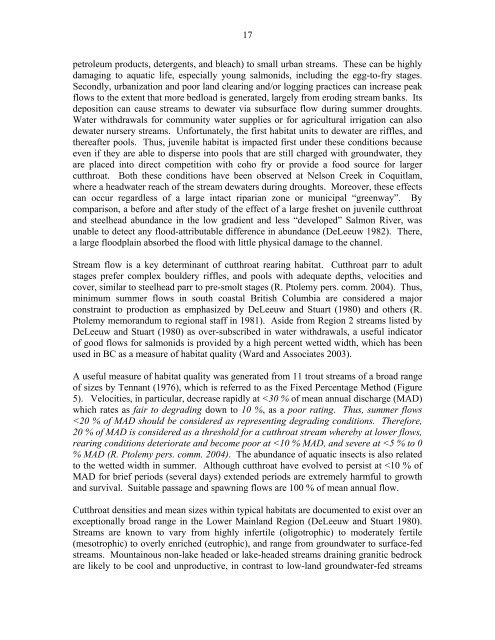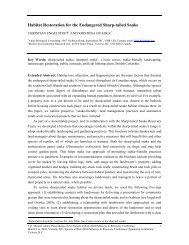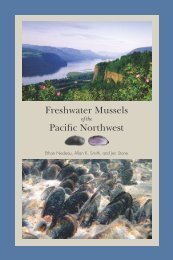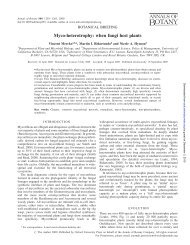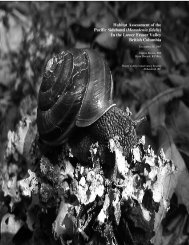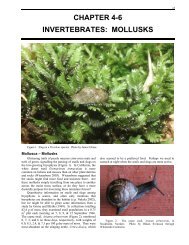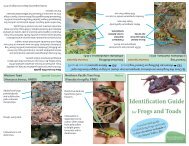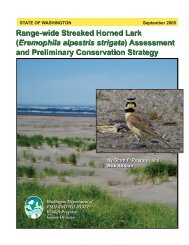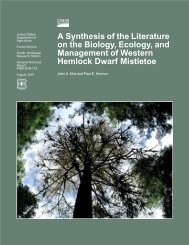Coastal Cutthroat Trout as Sentinels of Lower Mainland Watershed ...
Coastal Cutthroat Trout as Sentinels of Lower Mainland Watershed ...
Coastal Cutthroat Trout as Sentinels of Lower Mainland Watershed ...
You also want an ePaper? Increase the reach of your titles
YUMPU automatically turns print PDFs into web optimized ePapers that Google loves.
17petroleum products, detergents, and bleach) to small urban streams. These can be highlydamaging to aquatic life, especially young salmonids, including the egg-to-fry stages.Secondly, urbanization and poor land clearing and/or logging practices can incre<strong>as</strong>e peakflows to the extent that more bedload is generated, largely from eroding stream banks. Itsdeposition can cause streams to dewater via subsurface flow during summer droughts.Water withdrawals for community water supplies or for agricultural irrigation can alsodewater nursery streams. Unfortunately, the first habitat units to dewater are riffles, andthereafter pools. Thus, juvenile habitat is impacted first under these conditions becauseeven if they are able to disperse into pools that are still charged with groundwater, theyare placed into direct competition with coho fry or provide a food source for largercutthroat. Both these conditions have been observed at Nelson Creek in Coquitlam,where a headwater reach <strong>of</strong> the stream dewaters during droughts. Moreover, these effectscan occur regardless <strong>of</strong> a large intact riparian zone or municipal “greenway”. Bycomparison, a before and after study <strong>of</strong> the effect <strong>of</strong> a large freshet on juvenile cutthroatand steelhead abundance in the low gradient and less “developed” Salmon River, w<strong>as</strong>unable to detect any flood-attributable difference in abundance (DeLeeuw 1982). There,a large floodplain absorbed the flood with little physical damage to the channel.Stream flow is a key determinant <strong>of</strong> cutthroat rearing habitat. <strong>Cutthroat</strong> parr to adultstages prefer complex bouldery riffles, and pools with adequate depths, velocities andcover, similar to steelhead parr to pre-smolt stages (R. Ptolemy pers. comm. 2004). Thus,minimum summer flows in south co<strong>as</strong>tal British Columbia are considered a majorconstraint to production <strong>as</strong> emph<strong>as</strong>ized by DeLeeuw and Stuart (1980) and others (R.Ptolemy memorandum to regional staff in 1981). Aside from Region 2 streams listed byDeLeeuw and Stuart (1980) <strong>as</strong> over-subscribed in water withdrawals, a useful indicator<strong>of</strong> good flows for salmonids is provided by a high percent wetted width, which h<strong>as</strong> beenused in BC <strong>as</strong> a me<strong>as</strong>ure <strong>of</strong> habitat quality (Ward and Associates 2003).A useful me<strong>as</strong>ure <strong>of</strong> habitat quality w<strong>as</strong> generated from 11 trout streams <strong>of</strong> a broad range<strong>of</strong> sizes by Tennant (1976), which is referred to <strong>as</strong> the Fixed Percentage Method (Figure5). Velocities, in particular, decre<strong>as</strong>e rapidly at


